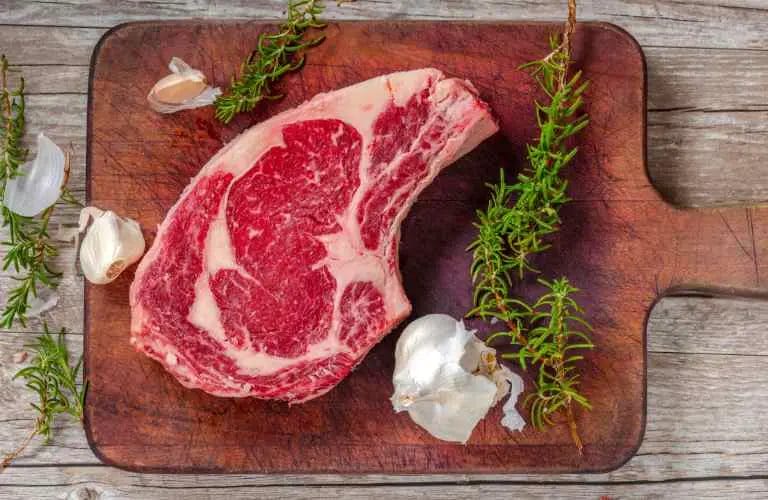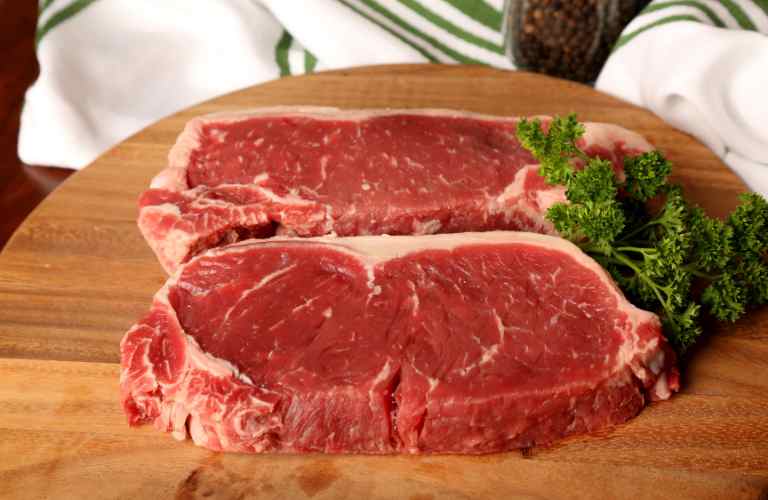There’s nothing quite like sinking your teeth into a perfectly cooked steak—a juicy, tender piece of meat bursting with flavor.
However, achieving steak perfection requires skill, knowledge, and attention to detail.
Many home cooks and grill enthusiasts often fall prey to common mistakes that can negatively impact the taste and texture of their steak.
In this comprehensive guide, we’ll delve into the ten most common mistakes people make when cooking or grilling steak and provide practical tips and techniques to help you avoid them. By mastering these pitfalls, you’ll elevate your steak-cooking game to new heights.
Top 10 Common Steak Cooking Mistakes
1. Choosing the wrong cut:
The journey to a great steak starts with choosing the right cut of meat. Different cuts offer distinct flavors, tenderness levels, and marbling. Let’s explore some popular cuts:
Ribeye:
Known for its rich marbling and intense flavor, the ribeye is a favorite among steak lovers.

It’s a well-marbled cut from the rib section, offering a tender and juicy eating experience.
New York Strip:
This cut comes from the loin region and boasts a balance of tenderness and flavor.

It has a good amount of marbling and a slightly firmer texture compared to ribeye.
Tenderloin:
Also known as filet mignon, the tenderloin is the most tender cut of beef. It has minimal fat marbling, making it lean but milder in flavor compared to other cuts.
Understanding the characteristics of each cut will enable you to make an informed decision that aligns with your preferences and cooking method. Explore different cuts to discover your personal favorite.
2. Not allowing the steak to reach room temperature:
To ensure even cooking, it’s crucial to let your steak come to room temperature before cooking. Many people make the mistake of cooking a cold steak straight from the refrigerator.

When a cold steak hits a hot cooking surface, it takes longer to cook evenly, resulting in uneven doneness.
Allowing the steak to rest outside the fridge for about 30 minutes to an hour will help it cook more evenly and prevent a cold center.
3. Skipping the seasoning or marinating process:
Seasoning is a critical step in enhancing the natural flavors of the steak. Before cooking, generously season your steak with kosher salt and freshly ground black pepper.
The salt not only adds flavor but also helps to tenderize the meat by breaking down its proteins. For an extra flavor boost, consider marinating your steak for a few hours or overnight.
Marinating can tenderize the meat and infuse it with additional flavors like garlic, herbs, or citrus. Make sure to pat the steak dry before cooking to promote a better sear.
4. Overcooking or undercooking:
Achieving the perfect level of doneness is a common challenge for steak enthusiasts. The key is to find the sweet spot where the steak is cooked to your desired level while retaining its juiciness and tenderness.

Here’s a breakdown of different levels of doneness and their corresponding internal temperatures:
- Rare: 120°F (49°C) – The steak will have a cool red center.
- Medium-rare: 130°F (54°C) – The center will be warm, red, and juicy.
- Medium: 140°F (60°C) – The center will be pink, firm, and slightly juicy.
- Medium-well: 150°F (66°C) – The center will be mostly gray with a hint of pink.
- Well done: 160°F (71°C) – The steak will be cooked throughout, with no pinkness.
Investing in a meat thermometer is a game-changer when it comes to achieving precise doneness.
Insert the thermometer into the thickest part of the steak, away from any bones or fat, to get an accurate reading. Avoid relying solely on visual cues, as they can be misleading.
5. Constantly flipping the steak:
While it may be tempting to continuously flip the steak, this can prevent the development of a beautiful crust and hinder the overall cooking process.
Flipping the steak too frequently can also cause it to lose moisture and become less juicy. Instead, adopt the “flip once” method.
Allow the steak to cook undisturbed on one side for a few minutes to develop a beautiful crust.
Flip it only once to ensure even cooking on both sides. Patience is key in achieving that perfect sear.
6. Cutting into the steak too early:
One of the cardinal sins of steak cooking is cutting into the meat immediately after removing it from heat.
When the steak cooks, the heat causes the juices to migrate toward the center. If you cut into it too soon, those flavorful juices will spill out, resulting in a drier steak.
To preserve the juiciness, let the steak rest for about 5 to 10 minutes before slicing into it. Place it on a cutting board or a warm plate and tent it loosely with foil.
This resting period allows the juices to redistribute, resulting in a more tender and flavorful experience.
7. Using high heat throughout the cooking process:
While high heat is necessary for achieving a caramelized crust, using it consistently throughout the cooking process can lead to uneven cooking. Start by searing the steak over high heat to develop a crust.
This initial high heat will lock in the juices and create that desirable outer crust.
However, after searing, lower the heat or move the steak to a cooler part of the grill or oven to finish cooking gently. This method ensures even doneness without charring the exterior.
8. Neglecting the quality of the meat:
The quality of the steak you choose has a significant impact on the final result. Opt for high-quality cuts of meat from reputable sources.
Look for well-marbled steaks, as the marbling contributes to tenderness and flavor. The marbling, or intramuscular fat, melts during cooking and imparts rich flavor and juiciness to the steak. Seek out well-known beef grades, such as USDA Prime or Choice, for the best quality meat available.
Investing in quality meat will undoubtedly enhance your steak-cooking experience.
9. Not resting the meat after cooking:
Resting the steak after cooking is a crucial yet often overlooked step. Allow the steak to rest on a cutting board or a warm plate tented with foil.
This resting period helps the meat retain its juices, making it more tender and flavorful. When the steak cooks, the heat causes the proteins to contract and squeeze the juices toward the center.
Resting allows the proteins to relax, preventing the juices from spilling out when the meat is cut. As a general rule, let the steak rest for about 5 to 10 minutes before serving.
10. Not cleaning the grill or pan properly:
A clean cooking surface is essential to prevent unwanted residue from affecting the flavor and texture of your steak.
Before cooking, ensure your grill grates or pan are clean and free from any leftover food particles. The remnants of previous meals can stick to the steak and give it an off-flavor. Use a grill brush or a damp cloth to remove any residue and ensure a clean cooking surface.
Regular cleaning and maintenance of your grill or pan will enhance the quality of your steak and prevent any undesirable flavors.
Conclusion:
Cooking the perfect steak requires attention to detail, patience, and a solid understanding of the common mistakes to avoid.
By following the tips and techniques discussed in this comprehensive guide, you’ll significantly improve your chances of achieving a delicious, tender, and flavorful steak every time.
Remember to choose the right cut, allow the steak to reach room temperature, season or marinate it, cook it to the desired doneness, flip it sparingly, rest it before slicing, adjust the heat accordingly, prioritize quality meat, rest it after cooking, and keep your grill or pan clean.
With practice and perseverance, you’ll soon become a master of cooking steak, impressing your friends and family with your culinary prowess. So, fire up the grill or heat up the pan and embark on your journey to steak-cooking mastery!
Frequently Asked Questions
Should I use a specific type of salt for seasoning my steak?
While there are different types of salt available, it’s generally recommended to use kosher salt or coarse sea salt for seasoning steaks.
These types of salt have larger crystals, which help to evenly distribute the seasoning and enhance the flavor of the meat. Avoid using fine table salt, as it can be too concentrated and may result in an overly salty steak.
How long should I marinate my steak?
The marinating time depends on the thickness and type of steak, as well as personal preference. Generally, marinating for at least 30 minutes to 2 hours can add flavor and tenderness.
For tougher cuts, such as flank steak, marinating overnight or up to 24 hours can yield better results. However, avoid marinating delicate cuts, like filet mignon, for too long, as it may overpower the natural flavor.
Is it necessary to let the steak rest after cooking if I’m serving it immediately?
Resting the steak is recommended, even if you plan to serve it immediately. Resting allows the juices to redistribute and the muscle fibers to relax, resulting in a more tender and flavorful steak.
Even a brief rest of 5 to 10 minutes can make a noticeable difference in the final texture and juiciness of the meat.
Can I achieve a good sear on a gas grill?
Yes, you can achieve a good sear on a gas grill. Preheat your grill to high heat, brush the grates clean, and ensure they are well-oiled to prevent sticking.
Place the steak on the hot grates and allow it to sear for a few minutes on each side, avoiding excessive flipping. The high heat will create a caramelized crust, imparting flavor and texture to the steak.
What is the best way to clean a grill or pan after cooking steak?
After cooking steak, it’s important to clean your grill or pan properly. For grills, use a grill brush to scrape off any leftover food particles from the grates while they are still warm.
For pans, let them cool slightly before using a non-abrasive sponge or brush with warm, soapy water to remove any residue. Rinse thoroughly and dry the grates or pan completely to prevent rusting.
Can I use a meat thermometer to check the doneness of my steak on the grill?
Absolutely! Using a meat thermometer is an excellent way to ensure your steak is cooked to the desired doneness.
Insert the thermometer into the thickest part of the steak, away from any bones or fat. Be cautious not to touch the thermometer to the grill grates, as it can give an inaccurate reading.
Consult a temperature guide to determine the desired internal temperature for your preferred level of doneness.
Is it possible to reverse-sear a steak for more even cooking?
Yes, reverse-searing is a technique that involves cooking the steak at a low temperature first and then searing it at high heat to finish.
This method allows for more even cooking and a consistent doneness throughout the steak. To reverse-sear, start by cooking the steak in a low-temperature oven or indirect heat on a grill until it reaches a few degrees below the desired internal temperature.
Then, sear the steak over high heat for a brief period to develop the crust.
Can I season my steak right before cooking, or should I season it in advance?
While you can season your steak right before cooking, it’s generally recommended to season it at least 30 minutes before cooking or even up to overnight.
Seasoning in advance allows the salt to penetrate the meat, enhancing the flavor and tenderness. If you choose to season just before cooking, be sure to pat the steak dry to remove any excess moisture before applying the seasoning.

